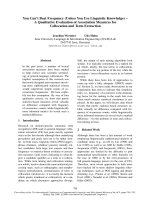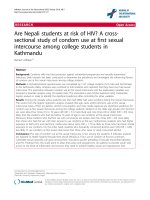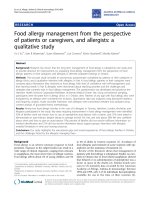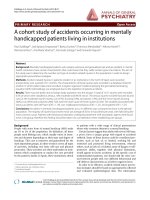Báo cáo y học: "Electronic patient record use during ward rounds: a qualitative study of interaction between medical staff"
Bạn đang xem bản rút gọn của tài liệu. Xem và tải ngay bản đầy đủ của tài liệu tại đây (1.04 MB, 8 trang )
Open Access
Available online />Page 1 of 8
(page number not for citation purposes)
Vol 12 No 6
Research
Electronic patient record use during ward rounds: a qualitative
study of interaction between medical staff
Cecily Morrison
1
, Matthew Jones
2
, Alan Blackwell
1
and Alain Vuylsteke
3
1
Computer Laboratory, University of Cambridge, 15 JJ Thompson Avenue, Cambridge, CB3 0FD, UK
2
Judge Business School, University of Cambridge, Trumpington Street, Cambridge, CB2 1AG, UK
3
Papworth Hospital, NHS Foundation Trust, Cambridge, CB23 3RE, UK
Corresponding author: Alain Vuylsteke,
Received: 2 Sep 2008 Revisions requested: 23 Sep 2008 Revisions received: 13 Oct 2008 Accepted: 24 Nov 2008 Published: 24 Nov 2008
Critical Care 2008, 12:R148 (doi:10.1186/cc7134)
This article is online at: />© 2008 Morrison et al.; licensee BioMed Central Ltd.
This is an open access article distributed under the terms of the Creative Commons Attribution License ( />),
which permits unrestricted use, distribution, and reproduction in any medium, provided the original work is properly cited.
Abstract
Introduction Electronic patient records are becoming more
common in critical care. As their design and implementation are
optimized for single users rather than for groups, we aimed to
understand the differences in interaction between members of a
multidisciplinary team during ward rounds using an electronic,
as opposed to paper, patient medical record.
Methods A qualitative study of morning ward rounds of an
intensive care unit that triangulates data from video-based
interaction analysis, observation, and interviews.
Results Our analysis demonstrates several difficulties the ward
round team faced when interacting with each other using the
electronic record compared with the paper one. The physical
setup of the technology may impede the consultant's ability to
lead the ward round and may prevent other clinical staff from
contributing to discussions.
Conclusions We discuss technical and social solutions for
minimizing the impact of introducing an electronic patient
record, emphasizing the need to balance both. We note that
awareness of the effects of technology can enable ward-round
teams to adapt their formations and information sources to
facilitate multidisciplinary communication during the ward round.
Introduction
Electronic patient records (EPRs) are progressively being
implemented in many hospitals. Although there is a growing lit-
erature addressing the difficulties of EPR implementation –
including doctor usage [1], user response to implementation
[2], doctor–patient communication [3], and organizational
issues [4] – it is a multifaceted issue with much still to be
understood [5]. In fact, most previous research provides useful
guidelines for various aspects of implementation but the need
remains to '[overcome] the cognitive and behavioural barriers
of machine-man interactions' in order to reap the promises of
EPR systems [5].
Ward rounds are a notable hospital context in which staff work
as a group. Technology designed for a single user, like most
EPR systems, poses challenges to group interaction – an
issue not widely discussed in the healthcare literature. Using
theory from the field of human–computer interaction, we eval-
uate EPR usage through a comparative study of interaction
during ward rounds in an intensive care unit (ICU) that transi-
tioned from a paper patient record to an EPR. We highlight the
role of physical group formation and the ergonomics of each
system in facilitating or hindering group use of patient records.
Materials and methods
Background
The medical lead of the ICU described in the present paper ini-
tiated a switch to an EPR from a paper record in order to
improve record keeping such as prescription legibility, adher-
ence to guidelines, and research and development opportuni-
ties. Funding was approved in spring 2006 for the purchase of
a commercially available clinical information system (Metavi-
sion; iMDsoft; Needham; Massachusetts; USA), which was
deployed bed by bed across the unit on 6 November. Between
the funding approval and the deployment, an implementation
steering group established a plan to introduce the system,
EPR: electronic patient record; ICU: intensive care unit.
Critical Care Vol 12 No 6 Morrison et al.
Page 2 of 8
(page number not for citation purposes)
overseeing the customization process to meet the needs of
the unit as well as examining probable changes, or disruptions,
to work practices.
The implementation steering group was particularly concerned
about how the new system might impact job satisfaction and
communication between various medical practitioners. With
the agreement of the trust authorities and the Caldicott guard-
ian, the steering group invited a multidisciplinary team of
researchers including social and computer scientists to
observe and record working practices pre and post change,
starting in summer 2006. Their observations were fed back to
the implementation steering group on a regular basis to help
them ensure a smooth migration from paper patient records to
EPRs. The researchers were not funded by the hospital, and
decisions to adjust work practices lay entirely with the imple-
mentation steering group.
As the research does not contain any patient data or interac-
tion, it has been classified as an audit by the Cambridgeshire
Research Ethics Committee and therefore does not require
ethics approval. All of the medical practitioners observed or
interviewed, however, were aware of the purpose of the stud-
ies – particularly the consultant videoed (author AV).
Data analysis methodology
Our analysis aims to answer the following question: How does
interaction during clinical ward rounds vary when an EPR is
used in place of a paper record?
Given the complex nature of interaction of multidisciplinary
communication in an ICU, we have chosen to triangulate three
types of qualitative data: video-based interaction analysis,
observation, and interviews. Video-based interaction analysis
is a technique intended 'to identify regularities in the ways in
which participants utilize the resources of the complex social
and material world of actors and objects' [6]. It is a technique
particularly useful for observing, and perhaps understanding,
the impetus of subtle changes in behaviour, and is the main
source of data presented in this paper. Observation provides
background information for the video analysis, and was used
to ensure the analysis was not limited by the scope of the cam-
era's lens. Interviews are useful for gathering information on
how the system is used, and in this case provided validation of
hypotheses generated during video analysis about the interac-
tion. Quantitative measures were not used as it was unlikely
they would provide external validity in this situation of complex
social interaction between specialized participants [7].
The primary function of ward rounds is to provide an occasion
for the medical team to review and integrate information as a
group in order to make a clinical decision [8-10]. As the paper
and electronic records present and allow access to informa-
tion in different ways, the change of record is likely to affect
interaction. We therefore chose to compare how interaction
was achieved with each type of record. The ward-round dis-
cussion needs to ensure that all necessary information is pre-
sented but time is not wasted. The interaction, then, is a
negotiation of how the topic of conversation advances and of
how people can enter the conversation [11]. Kendon demon-
strates in his theory F-formation Systems that groups negoti-
ate interaction (often unconsciously) by adapting group
formation, body orientation, and posture [12].
Using this analytical perspective to support the video analysis,
along with the data from observation and interviews, we dem-
onstrate how the ergonomics of the two record types affect
group formation. We consequently demonstrate the way in
which members of the ward round team use body orientation
and posture to negotiate interaction in terms of conversation
advancement and entry.
Data acquisition
Ward rounds were video recorded by author CM, trained in
anthropological techniques of field observation and video-
based interaction analysis. Video recordings were obtained at
three points during the observation period of 13 months: 1
month prior to deployment of the EPR, 4 months after deploy-
ment of the EPR, and 1 year after deployment of the EPR.
Each time, six separate, randomly selected patient discussions
were filmed. To enable comparison, those ward rounds
selected for filming were always managed by the same con-
sultant.
Images from the video recordings were shared with members
of the implementation steering group – including the consult-
ant videoed – 6 months after deployment of the system, and
the effects of the introduction of the EPR on group interaction
were discussed. Patient privacy was ensured at all times by
avoiding capture of images that might allow patient identifica-
tion.
Video footage was complemented by observation during the
above three periods both at the time of filming and on another
day. Further observation took place the week after deployment
and of other consultants throughout the observation period.
Three rounds of interviews were conducted at similar time
intervals by author MJ. Seven participants were drawn from all
medical and nursing roles, including at least one teaching
nurse who was responsible for carrying out the training on the
system. Effort was made to interview the same people each
time, but due to scheduling there were some substitutions.
Setting
Intensive care unit
The ICU, consisting of 25 critical care beds, is part of a spe-
cialist hospital that concentrates on all aspects of adult cardi-
othoracic care. Approximately 70% of admissions are patients
recovering from cardiac surgery. The unit has a high turnover
with a 3-day median duration of stay.
Available online />Page 3 of 8
(page number not for citation purposes)
There are approximately 200 practitioners working in the ICU,
with at least 30 on duty at any one time. These practitioners
include a consultant intensivist (senior doctor), two specialist
registrars on duty for critical care (junior doctors), one sister in
charge of the nurses in the unit (head nurse), one senior nurse
in charge of each of three clusters of patient beds, one nurse
looking after each of the 25 patients, the intensive care phar-
macist, the intensive care dietician, and a team of physiother-
apists. The large nature of the unit results in the on-duty group
changing configuration regularly.
Multidisciplinary ward round
The ward-round team is made up of a member from each of the
above roles as appropriate (for example, the bed nurse for that
patient) – consultant, two registrars, head nurse, senior nurse,
bed nurse, pharmacist, dietician and head of physiotherapy –
comprising eight to 10 people, with possible additional medi-
cal students or support from consultants, microbiologists, or
surgeons. Although the team structure is consistent, different
individuals may fulfil each role on a given day.
The multidisciplinary ward-round team travels from bed to bed
each morning to review patient progress. The team updates
itself on each patient's condition through discussion and chart
review, and decides upon the patient's plan for the day. As the
round is business orientated, aiming to review all 25 beds in
the short period of time ahead of postoperative admissions, lit-
tle time is devoted to teaching. The daily plan and prescrip-
tions, however, are filled out during the ward round when
possible.
The ward round begins with one of the registrars presenting
the most pertinent details of the patient and any recent
changes. The discussion that ensues is led by the consultant
working systematically through a number of issues, as appro-
priate. Any member of the ward-round team can contribute to
discussion or may be specifically called on by the consultant
for their expertise. The ward round is usually close by the con-
sultant asking 'is there anything else?' Although there is no
particular structure for participation by the medical staff, the
consultant videoed (author AV) strongly encourages participa-
tion from all of those involved in the ward round.
Patient records
Paper record
The paper patient record, shown in Figure 1, consisted of
three specific types of form (the observation chart, the drug
chart, and the plan of the day) and a folder or binder for mis-
cellaneous and patient-specific forms and papers. The obser-
vation chart was A3-size paper that lay flat on the nurse's table.
The nurse plotted vital signs on it regularly, recorded blood
test results, wrote other medical notes, and kept nonmedical
care information on the reverse side. A new chart was used
each day and was placed on top of the old one.
Electronic patient record
The EPR, provided by Metavision, is a system developed spe-
cifically for intensive care use, allowing full integration of data
gathered at the bedside into a highly customizable interface.
The record includes parameters from ventilators, monitoring
devices, laboratory results, prescriptions, and medical and
nursing records. A summary screen that displays the most
important information about the patient's condition was devel-
oped for use during the ward round. All other screens – that
is, those giving detailed data on particular aspects of a
patient's condition and treatment – are accessible via tabs dis-
played across the top of the summary screen as shown in Fig-
ure 2.
A multidisciplinary team at the hospital designed the initial
interface to be used in the unit before implementation. The
software allows the clinical design team to make changes on
the fly and to react to staff feedback, such that the interface is
constantly evolving. Consequently, there were no major soft-
ware issues and, fortunately, no technical difficulties.
The EPRs are displayed on 19-inch monitors positioned on an
adjustable height trolley at the end of each bed. The trolley can
be moved around the bed, but its range is limited because of
the wire connections to the ceiling. The screen cannot be
rotated, but the trolley itself can. The trolley is generally not
moved during the ward round, although the bed nurses fre-
quently adjust the trolley for themselves.
Results
Group formation
Group formation during the multidisciplinary ward round
changed considerably during the observation period, as dem-
onstrated in Figures 3, 4, and 5.
Figure 1
Paper patient medical recordPaper patient medical record. 1, binder; 2, drug chart; 3, patient plan
of the day; 4, observation chart; 5, personal notes.
Critical Care Vol 12 No 6 Morrison et al.
Page 4 of 8
(page number not for citation purposes)
How is the conversation advanced?
Body orientation
One month prior to deployment of the EPR, with the paper
record the consultant took his position at the head of the table,
leaning in towards the paper and spreading his hands across
it. His body orientation towards the charts suggests them to
be the primary focus of the conversation and everyone else ori-
ents towards the charts as well.
Four months after deployment of the EPR, the consultant's ori-
entation towards the screen displaying the electronic record
does little to direct the attention of those who cannot see the
screen. The consultant in this case loses his ability to guide the
focus of the group and, not surprisingly, the gaze of the medi-
cal staff in the outer ring tends to wander.
One year after deployment of the EPR, while the consultant
remains oriented toward the computer screen, the registrars
and medical staff have adjusted to form a horseshoe around
the patient's bed. From this position, the ward-round team can
easily monitor the consultant's gaze and reactions toward the
conversation. The team frequently follow his gaze to the
patient and monitor or keep their attention on the faces of
those speaking. The consultant leads the conversation, not by
focusing the team's attention on the data but on the conversa-
tion itself.
Figure 2
Electronic patient record summary screenElectronic patient record summary screen. The summary screen, displayed on a 19-inchscreen at the patient bedside, contains the most impor-
tant information about the patient's condition; it is the primary screen used during the ward round. All other screens – that is, those giving detailed
data on particular aspects of a patient's condition and treatment – are accessible via tabs displayed across the top of the summary screen. Patient
details have been removed.
Available online />Page 5 of 8
(page number not for citation purposes)
Posture
One month prior to deployment of the EPR, the posture taken
by the consultant – as shown in Figure 3, with his hand spread
across the paper charts – indicates his control of the conver-
sation's progression. From this position, he is able to point at
information, guiding the attention of the group and often the
people speaking. Numerous instances were observed of the
registrars modifying their presentations to match the data
being pointed at. The consultant further regulated the content
of the discussion by pulling particular charts into the middle of
the table, thus switching the topic of conversation.
Four months after deployment, when using the EPR, the per-
son with the mouse – typically the consultant – had the same
ability to guide the conversation noted previously. He could
only, however, direct the focus of those who could see the
screen.
One year after deployment of the EPR, the upright posture of
the consultant and his position, slightly farther back from the
computer so that his face could be seen easily, facilitated the
ward-round team in following the consultant's focus. It also
allowed the consultant to monitor the attention of the ward-
round team. A question to one of the medical staff was used
twice to refocus that person, providing another tool for the
consultant to lead the team.
How can people enter the conversation?
Body orientation
One month prior to deployment of the EPR, within the ward
round, side conversations often took place between the
nurses or between the pharmacist and another medical staff
member. To request such a conversation when using the
paper record, a chart was picked up and both parties reori-
ented themselves to it. In this position, the parties could have
a conversation while still visually monitoring the main conver-
sation.
Figure 3
The ward-round team using the paper patient recordThe ward-round team using the paper patient record. Classical dis-
tribution observed when the paper record was in use; the medical team
distributed itself in a horseshoe shape around a table at the end of the
bed, with the consultant at the top.
Figure 4
The ward-round team using the electronic patient record 4 months after implementationThe ward-round team using the electronic patient record 4 months
after implementation. A new formation, consistently observed during
the first few months after implementation of the electronic patient
record, with two rings of people. In the first week of implementation, the
group attempted to form a single ring around the computer – but this
proved impractical as no one could see the screen, so the double ring
was taken up.
Figure 5
The ward-round team using the electronic patient record 1 year after implementationThe ward-round team using the electronic patient record 1 year
after implementation. The same practitioner group 1 year later. The
group once again has formed a single ring, this time around the patient.
The medical staff looked at and touched the patient significantly more.
The consultant stood further back from the display, keeping more of the
group in his peripheral vision.









